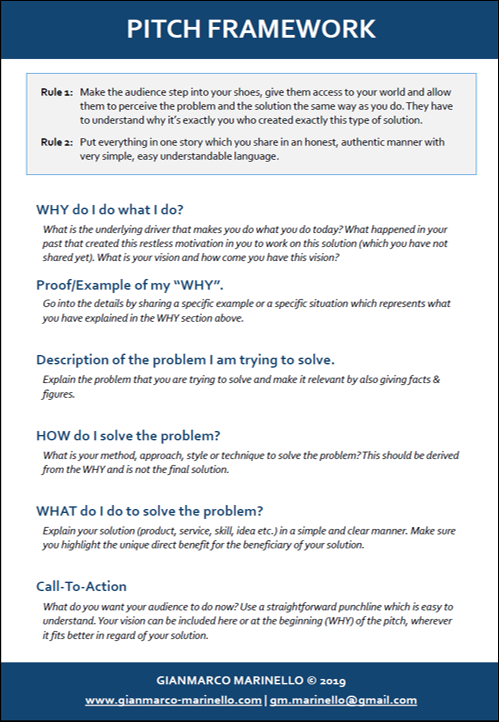
Nowadays, the term pitching can be found everywhere and there are many different frameworks that claim being the “best practice”. Pitching is dealt like either you master it or you don’t. This perception has always put a lot of pressure on me. But today, I believe there is nothing such as “the best” framework. It doesn’t matter how you pitch as long as you achieve the desired outcome. I made the experience that pitching works best, if the framework fits your person and your content. Because I couldn’t find such a framework among the existing ones, I started creating my own by drawing from others. Now, I want to share it with you for two reasons: I want to motivate you to come up with your own structure, and, I want to inspire you with the content from mine.
Before we jump into it, I have to explain first how I understand the term pitching: Convincing your audience in 1-2 minutes of your solution (idea, service, project, skill, product etc.) for a specific problem (job vacancy, customer need, social issue etc.) with the aim to make them take action (buy, donate, promote, employ etc.).
You believe in your solution, you know it’s outstanding and you know that you are the right person to solve the problem. This has to be given, otherwise you wouldn’t pitch, right? The question is, how can you make your audience believe in your solution the same way as you do.
Rule 1: Make them feel the same way about your solution as you do! Make them step into your shoes, give them access to your world and allow them to perceive the problem and the solution the same way as you do. This can be achieved by disclosing yourself: make the audience understand your underlying motivation, beliefs and values related to the problem that you are solving. They have to understand why it’s exactly you who created exactly this type of solution.
Rule 2: Put everything in one story which you share in an honest, authentic manner with very simple, easy understandable language.
Below you can find an example of how Mrembe – our office manager and one of our Nai Nami guides – pitches the tours to an audience by using my pitch framework. Download the framework and try to match the different parts of his pitch with the sections in the framework. Also, pay attention on how his pitch fulfils both rules mentioned above.
Mrembe’s Pitch
“I am Mrembe. I was born in the Mathare slum and raised by a single mother until I reached seven years. This was my age when she chased me away from home and when I had to start taking care of myself. I became one of the 60,000 street children of Nairobi.
Life on the street was hard. I still remember the cold nights with an empty stomach. To survive, I started begging, then stealing until I turned into a leader of a gang with 17 members doing mass robberies on Tom Mboya Street. At this point, I realised that if I want to have a future, I need to change my life. As you can imagine, the world doesn’t have anything to offer for a person like me. The same counts for the other 300,000 street kids in Kenya who also have a long criminal record and lack of formal education.
That’s why I came together with my friends to create our own job. We built on the only thing we had acquired on the streets: Street Skills and a Life Story. Nobody knows the dynamics of the streets better than we do, nobody has more insights and intimate stories to share about Nairobi than us. Street Skills and Life Stories are our past, and today we turn them into our future.
We offer to visitors a personal, one-to-one storytelling walking tour in downtown which is guided by people like me. Book a tour with us and we give you the unique opportunity to experience Nairobi through our eyes, through the eyes of a street child.”